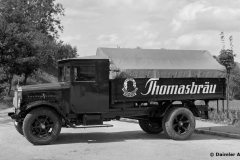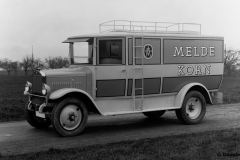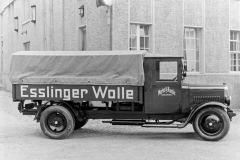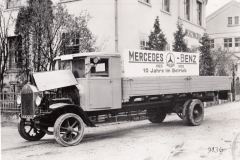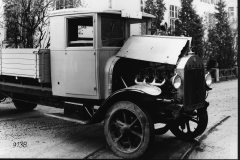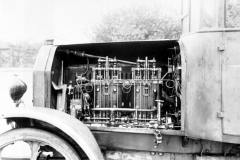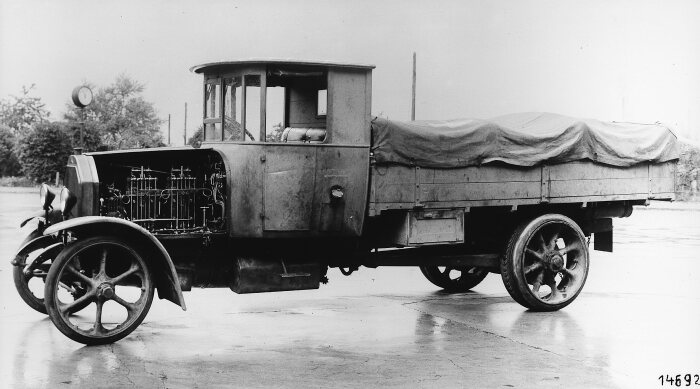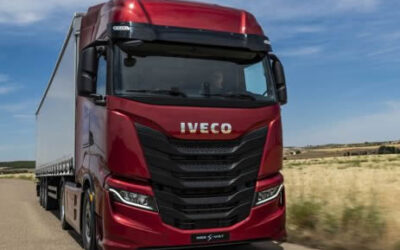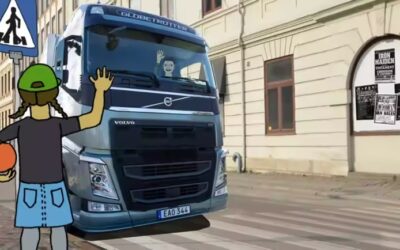In 1923 Benz & Cie. presented the first diesel truck to the world. The five-tonne vehicle was driven by a four-cylinder diesel OB 2 engine with an output of 33 kW (45 hp) at 1000 rpm. When compared with a petrol-driven truck of the same design, the efficiency of the diesel truck was immediately impressive: compared with the petrol engine, the diesel engine achieved fuel savings of 86 percent. Work on the new truck engine began in 1922. And in the September of that year the first major assembly was put on the test stand. Initially ten OB 2 engines were built.
First testdrives with the Benz Diesel Truck in the Northern Black Forest in September 1923
The first test drive was carried out in the challenging, hilly area around Gaggenau on 10 September 1923. The engineer’s report assessed the vehicle as follows: “The favourable consumption is particularly impressive: supplied with brown coal tar oil, the OB 2 requires around 25 percent less than a petrol engine with the same power.” The sensationally low fuel costs were due to the fact that the tar oil was cheaper than the petrol. And in addition to the tar oil, the new engine could also be “driven with gas oil, kerosene, Texas oil and yellow or brown paraffin oil” as Benz & Cie advertised the frugal engine in 1923.
The Benz engineers chose the chassis on the Benz 5 K 3 truck which was designed for a payload of five tonnes. During the test drives, the OB 2 diesel engine proved itself to such an extent that on 14 April 1923 it was decided that the engine would go into series production. The prechamber OB 2 diesel engine was capable of an output of 37 kW (50 hp) at 1000 rpm.
Air-injection diesel truck from Daimler – launched in October 1923
In 1911 Daimler-Motoren-Gesellschaft began development of a compact diesel engine for commercial and agricultural purposes. While Benz & Cie. were developing the diesel truck, Daimler-Motoren-Gesellschaft (DMG) in Berlin-Marienfelde was building an air-injection diesel engine to be fitted in a truck which boasted almost the same power. The finished product was a four-cylinder engine with an output of 29 kW (40 hp) at 1000 rpm. The engine proved its road capability during a series of test drives in 1923. The long-distance drive between the two DMG plants was particularly spectacular at the time: from 20 to 30 September 1923 a Daimler diesel truck drove from Berlin to Stuttgart and back. Following these tests which drew a great deal of publicity due to the then enormous distances, the first Daimler 5C commercial diesel vehicles produced in Marienfelde – a truck, a three-sided tipper and a bus – were presented at the beginning of October 1923 at the Berlin automobile exhibition.
The prechamber diesel engine prevails from 1927 at the newly merged Daimler-Benz AG
Following the merger of Benz & Cie. and DMG in 1926, Benz’s prechamber principle prevailed against the air-injection diesel engine. The first jointly developed prechamber diesel engine was the six-cylinder OM 5 engine from 1927 (55 kW/75 hp with a displacement of 8.6 litres). The abbreviation OM for diesel engines comes from “oil engine” and is still used today by Mercedes-Benz.
The Mercedes-Benz L 5 truck was fitted with either the new OM 5 diesel engine (51 kW/70 hp at 1300 rpm) or a petrol engine, type M 36 (74 kW/100 hp at 2000 rpm). The five-tonner (available with a low frame as N 5) was the only model with a diesel engine to be included in the new Mercedes-Benz commercial vehicle range presented in 1927. Both the 1.5-tonne and 3.5-tonne vehicles were initially only available with petrol carburettor engines. This was Mercedes-Benz’s reaction to its customers’ great scepticism of the diesel engine.
The OM 5 which went into series production in 1928 was fitted with the new Bosch injection pump. Robert Bosch had begun working on the diesel injection pump in 1922. In 1927 the systematically improved injection technology was presented and contributed to the acceptance of the diesel drive. Bosch himself was convinced of the diesel engine’s superiority: in 1924 he was one of the first customers to order a diesel truck from Benz & Cie.
Sales promotion of the new Mercedes-Benz Diesel truck
Initially sales were very slow because opponents of the new truck design criticised the loud and harsh running of the diesel engine. Yet again a positive response came from England. In June 1928 a 5-tonne diesel truck was delivered to British Mercedes-Benz Ltd. “Commercial Motors”, a specialist magazine of the time, praised the characteristics of the Mercedes-Benz truck in five consecutive issues. Then in the autumn of 1928, the Royal English Automobile Club awarded Daimler-Benz AG the Dewar Trophy, which was presented annually for special performances in the field of motor vehicle construction.
In an attempt to advertise the 5-tonne diesel truck which was still unknown in many parts of Germany, it was sent on a propaganda drive – today we would say marketing drive – which started from Leipzig in the summer of 1929 and which took the truck through all of Germany’s regions from the North Sea to the Alps and from the Ruhr to the Lausitz region in the East. At the same time, the benefits of the Mercedes-Benz diesel truck were also presented to the salespeople in dealerships and agencies. Also the diesel truck was loaned to waggoners and others who were interested in a test drive. The regional and specialist press also used the opportunity to report on the new and innovative drive technology in detail.

